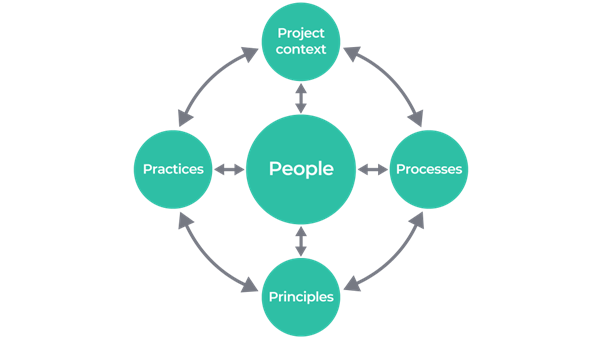10 Sprint Review experiments to switch it up!
Sprint Reviews are an essential part of the Agile development process, allowing teams to showcase their progress and gather valuable feedback from stakeholders.
However, traditional Sprint Reviews can sometimes become repetitive and fail to capture the true essence of collaboration and innovation.
Here are my 10 experiments you can try for your next Sprint Review!
1️⃣ Experiment number 1 - The raw and dirty.
If you spend a lot of time preparing the slides, doing demos, and doing dry runs, Try cutting in the time.
In the end, it's about the Product Increment and not the slides.
2️⃣ Experiment number 2 - Go on a stakeholder hunt.
Inspired by the book 'Zombie Scrum' by Barry Overeem, Christiaan Verwijs, and Johannes Schartau.
Go on a stakeholder treasure hunt. Find where your possible stakeholders work and invite them into your Sprint Review.
3️⃣ Experiment number 3 - Time's the key.
If you have struggled with people joining the Sprint Review, try experimenting with different time slots. Maybe there is a better time to hold your Sprint Review.
4️⃣ Experiment number 4 - Science Fair Sprint Review.
If you have multiple teams that do their Sprint Review simultaneously.
Why not hold a science fair Sprint Review? Each team has a stand where the stakeholders can come and try out the newly created Product Increment.
5️⃣ Experiment number 5 - Let a stakeholder present
When it's Demo Time during the Sprint Review, why not let one of your stakeholders give the demo?
You can prepare it with the stakeholders, but what is even better is not to prepare it.
Let them try it out on the spot. It'll give the team valuable insights into how your stakeholder uses it.
Of course, maybe discuss if they would be comfortable doing that beforehand.
6️⃣ Experiment number 6 - User interviews
Instead of doing a presentation and giving a demo.
It can give you much more valuable information if you and your team see actual users use what you've created.
While the team is watching, they can learn a lot about their current Product Increment.
Where do the users get stuck? Did our solution solve the problem we were trying to fix?
7️⃣ Experiment number 7 - Rotating presenters
Sprint Reviews can become dull and stale when there is always the same presenter.
To switch your next Sprint Review up, decide beforehand who will present which slide.
This will make the Sprint Review more engaging and allow the team to present their outcomes.
8️⃣ Experiment number 8 - Don't show everything
Decide what you'll show during the Sprint Review. Select the Increments you desperately need feedback on from your stakeholders.
Use this experiment when you have a Sprint Review where you don't have time to show all the Increments. This helps to create focus on what is essential for you and your team.
9️⃣ Experiment number 9 - Failure forum
You'll not succeed in achieving the Sprint Goal in every Sprint. But don't be afraid to show your failure.
To create a learning environment, it's important that you are open and transparent about your failures. Show where you've failed and what you've learned from it.
🔟 Experiment number 10 - Stakeholder spotlight
Put a stakeholder into the spotlight. Show the outcome of the collaboration with the stakeholder. What changed? What were the insights you created together?
This can show the other stakeholders what they can achieve when you work closely with your team.
There is even more! You can download the 10 Sprint Review cards for FREE with instructions on how to run the experiments for your next Sprint Review!
Hi! I'm Jelmar a Scrum Master
I write about my Agile learning journey. Writing about the challenges I face and how I navigate this uncertain world showing that work can be different.
Hey Reader 👋, No, not really, but you can apply concepts from PRINCE2 with your team to improve collaboration with stakeholders and freedom - yes, freedom - for your team. What is PRINCE2? First things first, for those who already know PRINCE2, feel free to continue. Else, here's a quick overview. PRINCE2 defines processes to effectively manage a project and stands for PRojects IN Controlled Environments. PRINCE2 is centered around people with their 7 Practices, 7 Principles, 7 Processes, and...
Hey Reader 🤟, Are you working Agile but hating it? Are you feeling fatigued? Agile fatigue is popping up left and right. So let's dive into this topic on what it is and how we can overcome it. What is Agile fatigue? First things first, let's define what I understand of Agile fatigue. “ It's a mental and operational fatigue caused by prolonged exposure to agile processes without any tangible improvement. Symptoms Now that we are on the same line. Let's explore how to recognize the symptoms of...
Poker Planning: Have The Right Estimation Discussions What is poker planning? Poker Planning, also known as Scrum Poker, is an estimation and facilitation method for aligning a team on a user story. The practice is most commonly used in software development, where an estimation of the work has to be done. Why use poker planning estimation? I use planning poker for the following benefits. Usually, within the team, you have strong characters that could take the stage at any time. This is not a...
